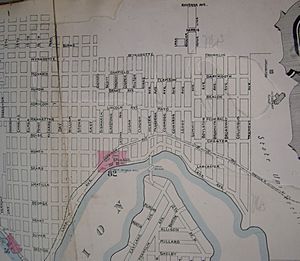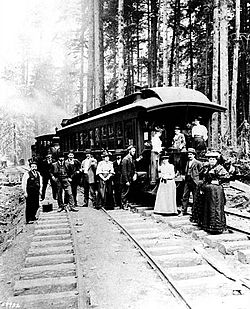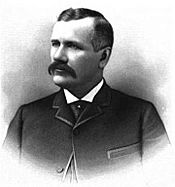Burke-Gilman Trail facts for kids
Quick facts for kids Burke-Gilman Trail |
|
|---|---|
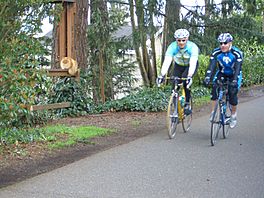
A cat watches over Lake Washington and bicyclists on the Burke-Gilman Trail
|
|
| Length | 19.8 mi (31.9 km) |
| Location | King County, Washington |
| Use | Multi-use |
| Trail map | |
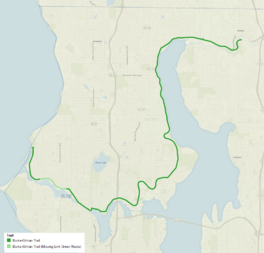
Map of Burke-Gilman Trail including proposed Green Route connection of the "missing link."
|
|
The Burke-Gilman Trail is a popular path in King County, Washington. It's a special kind of trail called a rail trail. This means it was built on an old railroad line. The trail is about 27-mile (43 km) long. It's used for many activities like biking, walking, and running.
This trail is part of the King County Regional Trail System. It follows the path of an old railroad called the Seattle, Lake Shore and Eastern Railway. The Burke-Gilman Trail starts in Ballard, a neighborhood in Seattle. It then goes along the Lake Washington Ship Canal and north along Lake Washington.
When the trail reaches Blyth Park in Bothell, it changes names. It becomes the Sammamish River Trail. This trail continues for 10 miles (16 km) to Marymoor Park in Redmond. From there, you can connect to the East Lake Sammamish Trail. This trail network can take you all the way to Issaquah. The longest connected part of this trail system is now 42 miles long!
Exploring the Trail's Path
The Burke-Gilman Trail is a big part of the bike routes in Seattle. It's also a key piece of the King County Trails System. A newer part of the trail opened in 2005. This section runs for about 0.7 miles (1.1 km) near the Ballard Locks. The main trail then continues for 17 miles (27 km) to Blyth Park in Bothell.
The trail follows interesting waterways. It runs along the Fremont Cut and Lake Union. You can even see an old freight building near Stone Way. The trail also goes through the University of Washington campus.
After passing the University Village shopping center, the trail heads into northeast neighborhoods. It passes by places like Hawthorne Hills and Laurelhurst. You'll also go through the Sand Point neighborhood, passing Magnuson Park.
The trail then follows Lake Washington past Matthews Beach and Cedar Park. It continues through Lake Forest Park and Kenmore before reaching Bothell. Because it was once a railroad, the trail is mostly flat. This makes it easy for everyone to use!
How the Trail Began
The story of the Burke-Gilman Trail starts a long time ago. It began with the Seattle, Lake Shore and Eastern Railway. This railroad was founded on April 15, 1885. Two important people, Judge Thomas Burke and Daniel Gilman, started it.
In its busiest days, this railroad stretched from Downtown Seattle all the way north to Arlington. It also went east to a place called Rattlesnake Prairie. Around 1890, a bigger railroad company, the Northern Pacific Railway, took it over. Later, it became part of the Burlington Northern Railroad in 1970. But in 1971, the railroad line was no longer used.
In 1978, the first part of the old railroad path was opened as a public trail. This first section was about 12.1 miles (19.5 km) long. It went from Seattle's Gas Works Park to Kenmore. The trail was named after the two founders of the railroad, Thomas Burke and Daniel Gilman.
The Burke-Gilman Trail officially ends in Bothell. But the old railroad path continues! You can follow it on other trails. These include the Sammamish River Regional Trail and the East Lake Sammamish Trail. Parts of the old railroad line are even used by the Northwest Railway Museum.
There's still a small part of the trail that isn't connected. This is called the "missing link." It's in the Ballard area. This part of the trail would go through an industrial area. Some businesses are worried about safety. They are concerned about bikes and people being near trains and trucks. But the city and other groups believe it can be made safe. The trail can sometimes get very busy, especially on nice days!
For a short time, from June 2011 to February 2012, a two-mile section of the trail in Lake Forest Park was closed. It was being updated and improved.
Neighborhoods Along the Trail
The Burke-Gilman Trail passes through many different neighborhoods and towns. Here are some of them:
- In Seattle, from west to east and north:
- Ballard
- Fremont
- Northlake (also called south Wallingford)
- University District
- The trail also runs alongside:
-
- University Village shopping center
- Hawthorne Hills
- Laurelhurst
- Windermere neighborhoods
- Sand Point neighborhood, passing Magnuson Park
-
- In the Lake City area, it passes:
-
- Matthews Beach
- Cedar Park
-
- Suburban towns northeast, east, and then south:


